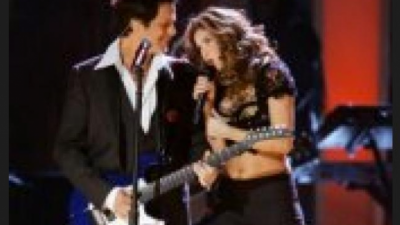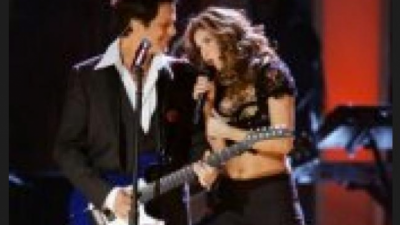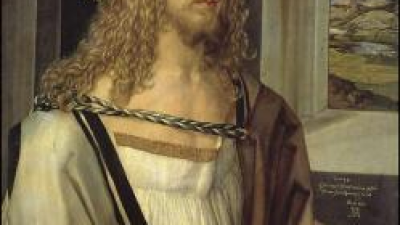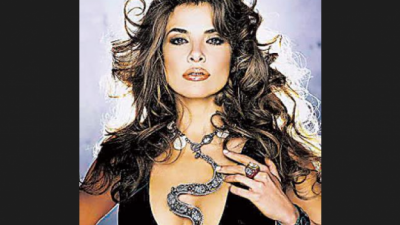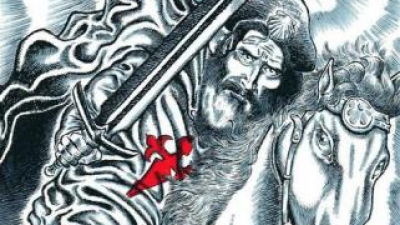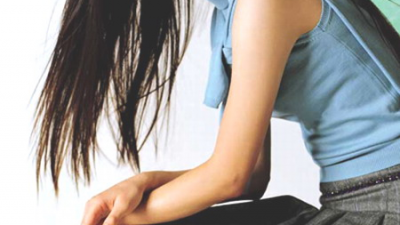The most famous musical instruments of the Renaissance
|
MUSIC
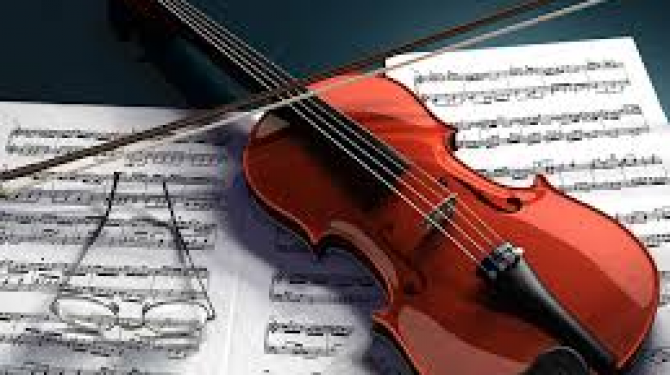
Source: listas.20minutos.es
We call musical instruments of the Renaissance those used for the interpretation of western cultured music during the fifteenth and sixteenth centuries. There were instruments of all kinds such as the violin, the harp ... You can vote, comment and add some element.
TOP 20:
Xylophone
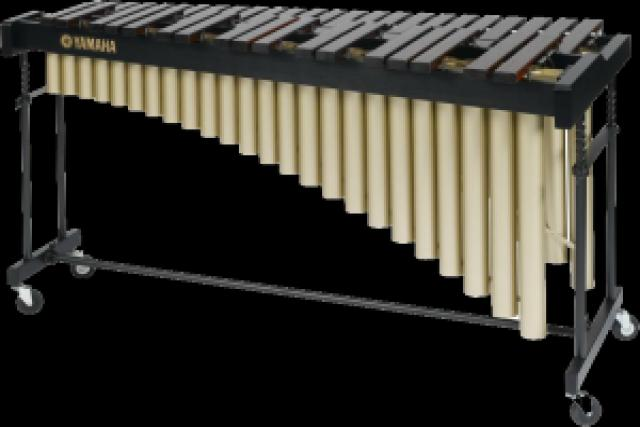
The xylophone is a musical instrument made of wooden sheets. These plates are inside a resonance box where they are hit with a stick.
TOP 19:
The Pífano
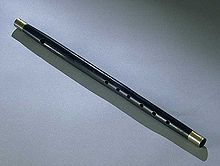
The fife is a wind musical instrument consisting of a very sharp little flute that is played crossed. It seems that it was the Swiss who introduced the fife into their regiments after the battle of Marignan (1515). It was later adopted by the French and later spread to other nations.1 It has traditionally been an instrument played in infantry accompanied by the box. Subsequently, its use led to bands or brass bands of the infantry regiments, with the exception of the companies of halberdiers, which continued to use it as before.
TOP 18:
Consort
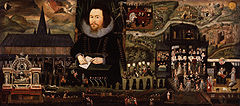
A consort is a chamber set consisting of instruments of different sizes belonging to the same instrumental family. It is the prototypical set of instrumental music of the Renaissance. The origin of the consort, like that of Renaissance instrumental music in general, is the interpretation of vocal polyphony. The instruments had to adapt to the different vocal tessituras, creating for it complete families of similar instruments but of different sizes; such instruments used to be used later in homogeneous groups. The most common consorts were formed, of course, by the most widespread instruments, such as the recorders or violas da gamba, but those formed by bass, lutes, etc. were also common. Each set used to consist of between three and six instruments; in this way, for example, a consort of violas da gamba could be formed, typically, by a viola soprano, two tenor violas and two violas bass. The current string quartet (formed by two violins, violoncello and viola) is an example of consort originated around 1600 and survives even today. Seventeenth England saw a great repertoire for consort of violas da gamba flourish, with authors such as John Dowland (Lachrimae or Seven Teares, 1604), Gibbons, Coprary, Lawes and, finally, the Fantasies of Henry Purcell. The broken consort was a group made up of instruments from different families. It usually designates specifically some combination very used in the Elizabethan England.
TOP 17:
Cornetto
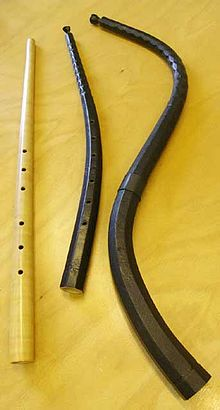
The cornetto, also known as the Renaissance bugle, black bugle or curved bugle is a wind instrument from the medieval, Renaissance and Baroque period. It should not be confused with the current bugle, which although it looks like the name, refers to different things. This instrument was used in the Renaissance. The cornet (its authentic name in Spanish, as we will see in the Nomenclature section) has the shape of a tube, about 60 centimeters long, made of wood, ivory, or in the case of some modern models reconstructed, ebonite, with fingering common to wooden instruments. Usually the cross section of the instrument is octagonal, and it is covered with leather, with the holes penetrating this coverage. The cornetto is slightly curved, usually to the right, improving the comfort of the interpreter who then digs the upper holes with the left hand and the lower ones with the right. This position is practically the standard for wooden instruments. At the upper end of the instrument there is a small mouthpiece, of the type used in metal instruments, where vibration is generated with the lips. For this reason the cornetto is an unusual construction instrument among the winds; a body in the style of wood (clarinet, flute, bassoon), with a mouthpiece - and consequently the generation of sound - in the style of metals (trombone, trumpet, cornet). Several scholars say that the last criterion is the most important, which classify cornetto among metals. In particular, the Hornbostel-Sachs instrument classification system places the instrument among the trumpets. The purist interpreters of the cornetto tend to use a smaller mouthpiece than they would need to be able to interpret modern metal instruments, since another option is to turn the base of the current nozzles so that they can fit into the body of the cornetto. Historically, the cornetto was used in conjunction with the sacabuche, often to bend a church choir. This was particularly popular in Venice, in the basilica of San Marcos, where the style was frequently used especially in antiphonal choirs. Giovanni Bassano was an example of virtuoso of the cornetto, and Giovanni Gabrieli wrote much of his splendid polyphonic music thinking about him. Heinrich Schütz also used the instrument extensively in his early work; he studied in Venice with Gabrielli, and was aware of Bassano's virtuosity. Also the cornetto, like all Renaissance instruments, was built in a complete family; the different sizes begin with the sharp cornetino, the cornetto, the lizard, or cornetto tenor and the rare cornetto bajo or serpentón, which consists of a curved instrument without a mouthpiece, used as a bass in string ensembles or sweet flutes. The instrument was used as a solo instrument, and a relatively large number of solo cornetto pieces survive. The use of the instrument declined around 1700, although it was common in Europe until well into the eighteenth century. Johann Sebastian Bach, Georg Philipp Telemann and the great German composers of the time used cornetto and cornetino together in their cantatas to play in unison with the soprano voice of the choir. Occasionally these composers included a part of solo for the instrument, (for example in cantata BWV 118 of Bach). Alessandro Scarlatti used the cornettos in several of his operas. Johann Joseph Fux used a pair of cornettos with mute in a Requiem. One of the last known compositions was that of the opera Orfeo and Eurydice by Gluck, where the soprano trombone is suggested as an alternative. It is interesting to know that Gluck was also the last of the composers of the time to include a part for the recorder in the play. The cornet is generally considered a difficult instrument to play. It represents a design that survives in ancient instruments, that is, the main tube has only the length of a typical wooden instrument, but the mouthpiece is of the metal type, forcing the performer to produce the sound vibration with his lips. Most modern metal instruments are considerably longer than the cornetto, which makes it possible to use the resonance of the tube more easily to control the tuning. The Baroque music era was relatively tolerant of brilliance and extraverted tonal quality, as witnessed by surviving organ music. Thus, Baroque music theorist Marin Mersenne describes the cornetto sound as "a ray of sun piercing the shadows". Even so it is also evident that the cornetto was often badly touched. His upper register sounds like a modern trumpet or bugle, while his grave record resembles the sacbuche that often accompanies him. The record
TOP 16:
Violone
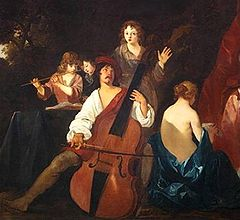
A violone is a large rubbed string instrument. Currently the term is reserved for historical instruments or reproductions of them, strung with gut and used for the interpretation of music with historicist criteria, and may even designate the contrabass when it is used according to such criteria. A more restrictive use of the term specifically designates instruments of the family of the viola da gamba, equipped with frets, existing two basic variants: The Violone in Sun, tuned Sun, -Do-Fa-La-re-sol, that is, a fifth bass of the viola da gamba bajo convencional. The Violone in Re, tuned Re, -Sol, -Do-Mi-la-re, that is, an octave low of the viola da gamba under conventional, and used to bend the octave to the bass lines. However it is now possible to find other tunings and instruments of less than six strings. Finally, the word "violone" also designates an organ record, although in Spanish the term violon is often used for it. The historical use of the word "violone" has given rise to harsh polemics among scholars about its exact meaning, due on the one hand to the imprecision with which the term itself has been used since the sixteenth century and, on the other, to the enormous variability of sizes, models and tunings that have been (and still are) among the serious instruments of rubbed string, always far from standardization. The first violoni are already used in the sixteenth century, and Praetorius in his Syntagma Musicum recorded, as early as 1619, a great variety of tunings. During the seventeenth century the word was used mainly to name the violone in Sol and the violoncello (Italian term meaning literally small violone), for example Arcangelo Corelli earmarking the accompaniment of his Op. V (Sonate a Violino e Violone or Cimbalo, Rome, 1700). Throughout the eighteenth century the violone in Sol gradually falls into disuse, the word being finally reserved for instruments that bend the bass to the octave, like the contrabass.
TOP 15:
Bassoon
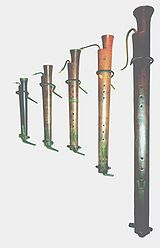
The bassoon is a wind-wood musical instrument created in the Renaissance. It consists of a long tube of bent wood with a conical section, in one of whose ends a copper tudel of curved form is inserted in which in turn a double reed or rod is inserted with which the instrument is made to sound. It has holes and a pair of keys to facilitate fingering. Although it used to be manufactured in different sizes forming an entire instrumental family, which included the small bajoncillos for the sharpest tessituras, the most typical model reinforced the bass line of the polyphony in the Renaissance chapels (function from which its name comes1) , sounding along with the rest of the wind instruments of the minstrels (cornetto, chirimía, sacabuche, flute of pico) and accompanying the psalmists in the ecclesiastical offices. It reached its peak around 1600, with prominent interpreters such as Bartolomé de Selma and Salaverde. Although during the XVII century its functions were assumed in almost all Europe by its natural successor, the bassoon, in the conservative Hispanic ecclesiastical music the bajon had a long permanence, coexisting even for centuries with it. According to the obsolete definition of the Espasa Encyclopedia, perhaps reflecting a tradition not yet completely disappeared around the year 1900, the bassoon had "metal pavilion", "was invented by Rigibo in 1780 and was used to accompany the plain song" .2 However, we must wait until the second half of the 20th century for the instrument to be recovered in the context of the interpretation of ancient music with original instruments. The word bash also designates a record of the organ.
TOP 14:
Cromorno

The cromorno or cromchorno is an aerophone musical instrument that was popular during the Renaissance. During the twentieth century there was a renewed interest in ancient music, so the instrument began to be used again. Its name comes from the German Krummhorn, 1 which means "horn (-horn) curved (Krumm-)". The cromorno is an encapsulated tongue instrument. Its structure is similar to the tube of a bagpipe. A double tongue is mounted inside a chamber inside the end of a long thin tube. Blowing inside the chamber expelling strong air produces a sound. The height or frequency of the sound can be modified by opening or closing the holes along the tube with your fingers. An unusual characteristic of Chromorno is its form; the end curves upward, so the instrument resembles a banana, or to be more prosaic, a letter "J". The sound of the instrument is strongly buzzing. It has a limited range, usually one octave plus one note. Although theoretically it is possible to obtain up to 12 tones on the fundamental note, this is extremely difficult since the tongue is not within reach of the mouth. In practice, therefore, all instrumentalists are limited to the fundamental octave. Larger models extend their range towards the grave register by means of additional holes and keys, or by controlling the air pressure. Because of the limited tessitura, the music for cromorno is usually played by a consort of instruments2 of different size and tonality.
TOP 13:
Sackbut
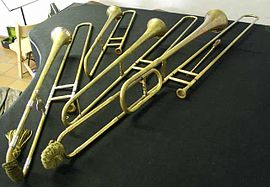
The Sacabuche, is a wind instrument from the Renaissance and Baroque period, ancestor of the modern trombone of rods. The name derives from the French "sacquer" and "bouter" (pull or pull, and push) and the term survives with numerous variations in English ("sacbut, sagbut, shagbolt, shakbusshe"), in German ("Posaune"), in Italian ("Trombone"), in French ("Sacqueboute") The term "sacabuche" is used to differentiate the historical instrument from its modern counterpart. The growing interest in the interpretation with the original instruments has linked many musicians with the sacabuche. The sacabuche derives from the medieval family of trumpets. Originally from the Middle Ages, the first reference to the instrument dates back to 1468, at the wedding of Carlos el Valiente and Margaret of York in Bruges, during which a trompette saicqueboute was used. The movement of the tube allows interpreting the entire chromatic scale, so that in its time it was considered the most refined and complete nozzle instrument. The instrument evolved into what we know today as a trombone, but it is usually described with a softer sound. It was used mainly in high, tenor and low sizes. It was one of the most important instruments in the works of the Venetian polyphonic school of the Baroque, together with the cornet and the organ. Compared to a current tenor trombone, the sacbuche is considerably smaller, with a smaller diameter tube and a smaller bell. The sacabuches come in several registers. According to Michael Praetorius, there were the alto, the tenor, the fourth and the fifth bass, as well as the double bass. The most usual at present is the alto in E flat, tenor in D flat, low in F (fourth) or Mi B flat (fifth). The lows, due to their length, have a handle on the fixed bar, which is used to allow the most open position. The Renaissance wind ensembles typically had a pitch of La = 415 Hz., Half a tone lower than the modern tuning. The tenors that survive in B flat are tuned with the = 415 Hz. Other sources of the time describe a high in the tenor in the low and in me. Some ensembles began using positions in and on me to interpret medieval works with greater precision, instead of transposing them half tone upwards. The sound of the sacabuche is characterized by a more vocal tone, more delicate than modern instruments. Its dynamic flexibility allows for a vocal style of interpretation and facilitates the most effective articulation of phrasing. The sacbuche replaced the pipe trumpet in the fifteenth century, with sets that were common in cities throughout Europe. It has also been used in sacred music, both for instrumental music (brought to a fine art by the Gabrieli family at the end of the 16th century in Venice) and for dubbing the choral polyphony. In this case the soprano and contralto parts were often played by cornet or by shawms (medieval oboe), with the cornet often replaced by violins in seventeenth-century Italian music. The sacabuches also played in the courts (dance music). In the seventeenth century there was a considerable repertoire of chamber music for sacabuche, in various combinations with violins, cornets, dulzainas, often with continuo. Some of the composers were Dario Castello, Giovanni Battista Fontana, Johann Heinrich Schmelzer, Giovanni Paolo Cima and Andrea Cima. Giovanni Martino Cesare wrote "La Hyeronima", the oldest known piece for solo trombone with accompaniment. Daniel Speer (1636-1707), a German composer, wrote important treatises on music theory and how to play the instruments of his time. His Sonata for trumpet and three sack hooks, the Sonata for three sackcloths, the Sonata for four sackcloths and the Sonata for two trumpets and three sappers show their mastery in composing perfectly for metals. The German organist and composer Johann Rudolf Ahle, in 1674, published a number of collections specifying the use of snapshots (up to seven in one composition), bugles and trumpets, as well as violins and violas. Johann Sebastian Bach composed his Cantata No. 4 "Christ lag in Todes Banden" (1707) with cornet, sack, strings and basso continuo. Probably the finest piece of Bach's works that use cornets and sack hooks is his Cantata No. 118 "O Jesu Christ, mein Lebens Licht", with cornet, two lituii (similar to the trumpet) and three sackboys. He declined the use of the sacbuche or trombone in formal music after the 1700s, but remained constant in town bands.
TOP 12:
Spinet
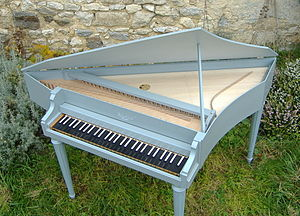
The spinet is a keyboard instrument. It is very similar to the key. As in the key, each order (key) corresponds to a single string. Its mechanism consisted of a series of vertical levers provided with plectrum (pen points), which pressed the strings under the pressure of the fingers on the keys. The strings are short and arranged diagonally inside the box. The spinet is named after the Italian builder Giovanni Spinetti, who lived in Venice during the second half of the 13th century and who was one of the first manufacturers (since similar instruments are known in Italy in the twelfth century). Its maximum splendor is located in the S. XVI and S. XVII. There are spinettes of two keyboards, which are placed one protruding below the other (as in the organ).
TOP 11:
Virginal
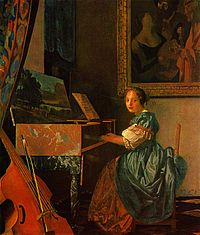
The virginal is a type of key, harpsichord or spinet but smaller, differently (oblong or rectangular) and with a single keyboard along the instrument, not at one end. It has been revived in the twentieth century to play ancient music. It spread in the Netherlands (in the 1500) and in England (in the 1600). Their strings ran parallel to the keyboard or, sometimes, diagonally. The name probably comes from the Latin virga, palo, verga, rod or martinete; it could also come from the Latin virginâlis ('virginal') which would indicate the fact that it was usually played by girls; instead, the theory that it derived from the Virgin Queen has been discarded because it was known as virginal from many years ago. The Italian term spinetto or spinet is used both for the virginal and for a similar instrument in the shape of a bird's wing.
TOP 10:
Clavichord
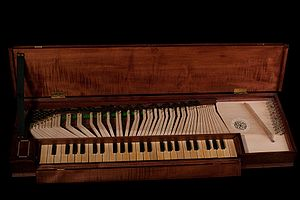
The clavichord is a European musical instrument of keyboard, percussion string and very weak sound. This instrument should not be confused with the key (harpsichord, harpsichord, harpsichord, harpsichord), the spinet or the virginal. The harpsichord keys are simple levers; when one of them sinks, the string is punched with a small metal prong ("tangent") inserted at the opposite end of the key. This tangent determines the pitch (pitch) of the string by dividing it by its length. The length of the string between the bridge and the tangent determines the pitch (pitch) of the sound. One of the two parts of the split string does not sound because it is in contact with a sharp felt band. The interpreter can make a small vibrato (fast and almost imperceptible variation of the tuning) by performing an effect with his finger, called in German Bebung ('tremor'): he varies the force with which he holds the key while the tangent is in contact with the rope. When the hammer leaves the rope, it stops ringing and has a rapid extinction curve. The harpsichord, unlike the harpsichord, has a "touch response": depending on the strength of the attack, the intensity can be varied, although it will always be very weak. From the harpsichord mechanism - which allows playing with different dynamics between the piano (soft) and the forte (strong) -, the Italians created the pianoforte (the current piano), which displaced its two predecessors, the harpsichord and the harpsichord . In Barcelona the workshop of "MANUEL BORDAS" stood out in the craftsmanship of Clavicordios. As the strings vibrate from the bridge only to where the hammer was applied, several keys with their respective hammers can be assigned to the same string (as in the monochord) . This system is called "fretted clavichord" (fretted clavichord). This technique simplifies the construction (due to the fact that fewer strings are required) but limits the skills of the instrument since in each string only one height (note) can be executed at a time. That's why it was very rare to be assigned more than two notes to each string. Generally, to share the same string, pairs of notes were chosen that were never heard together at that time (for example, the do and the do #, failing that, the trine was preferred, that is, very fast variation of the note). any music written for key, piano or organ can be played with harpsichord, its sound is too thin to play in chamber ensembles. Carl Philipp Emmanuel Bach (son of Johann Sebastian Bach) was a great composer of works for clavichord. The clavinet, which was used in funk music and rock since the fifties, was basically an electric harpsichord that used a magnetic capsule to generate an amplifiable electrical signal.
TOP 9:
Hornpipe
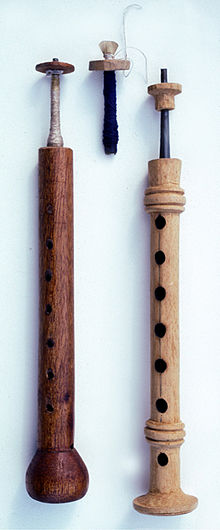
The chirimía is a wind-wood double-reed musical instrument, formerly worked rudely and carved by nine lateral holes, six only, intended to be covered by fingers, sharp, high and low.1 It is the ancestor direct from the oboe, and very similar to the dulzaina. The name comes from the French «chalemie», which in turn comes from the Latin «calamus», cane, and this in turn from the Greek «aulós kalamitēes», flute from cane.2 It was commonly used in Europe since the XIII century, and taken to the Hispano-American colonies from the end of the fifteenth century. 1. Chirimía (Colombia, Guatemala); 2. Ghaita (Morocco); 3. Mizmar (Tunisia); 4. Sib (Egypt); 5. Zumari (Kenya); 6. Kaba Zurna (Turkey); 7. Zurna (in A-flat) (Turkey); 8. Sorna (Iran); 9. Sharnai (Pakistan); 10. Rgya-Gling (Tibet); 11. Pi nai (Thailand); 12. So-na (China); 13. Vombard (Brittany); 14. Ciaramella, Cialamedda (Southern Italy); 15. Piffero (Northern Italy), Colombia (Different sectors such as popayan) It is used in popular, profane and religious celebrations. During the sixteenth century, the chirimia of Spain reached the Americas. In Mexico, among the Nahuas of the western region one of the old versions of chirimia was adopted, whose particular characteristic is the use of four tongues made of real palm instead of reed, tied to the tubillo or tudel as a stopper. The ensemble of chirimia in Jalisco and Oaxaca is composed of two musicians: one that plays the chirimía (double-barbed aerophone) and another that perches a drum (double-patch membranophone). In Tlaxcala and the State of Mexico, the group that plays chirimia is known as the Aztec band, and it carries huéhuetl and tambor drummer. In Mexico it is also called chirimía to certain flute and tamboril music. In Guatemala, various Mayan and mestizo celebrations use the chirimía and the tum (drum) as accompaniment. In Peru the chirimia is also known as "chirisuya"; and in Bolivia, as "chirituya".
TOP 8:
Triangle (musical instrument)
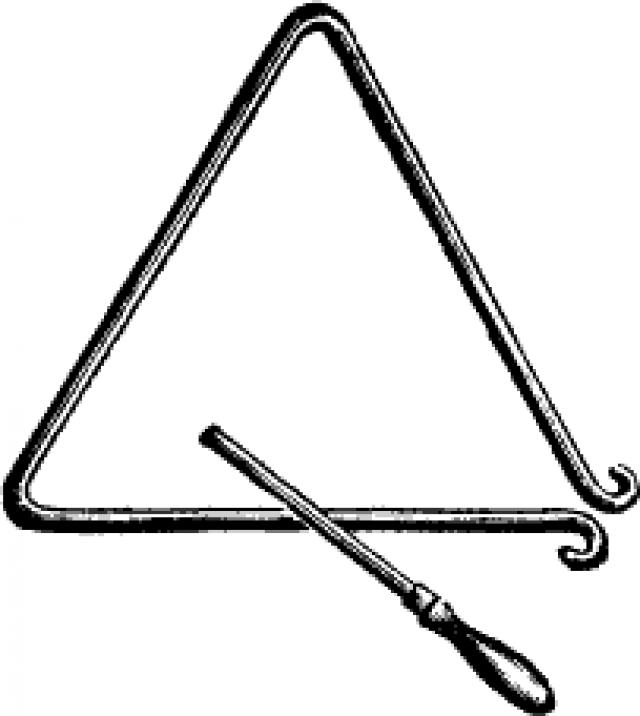
The triangle is a percussion instrument of steel, belonging to the group of idiofonos, because the resulting sound is the result of the vibration of the metal after being hit with the stick. The triangle is a bar or cylindrical structure of steel bent in the shape of a triangle, as the name suggests, with the particularity that one of its vertices is open. Normally, the performer does not directly support the instrument by doing it on one of its sides but by a string that, tied to the top vertex, serves to suspend it. The sound of the triangle is very good sharp and of indefinite height, which does not mean that it does not generate certain notes. The musician can make the sound of the triangle open or closed depending on how he holds it. The triangle has great sonority, which allows it to be heard above the orchestra. It is used in Cajun music in Louisiana and in the Brazilian forró. The musical triangles measure an approximate of 16 to 20 cm. In classical music, it has been used in the orchestra since the mid-eighteenth century. Mozart, Haydn and Beethoven used it frugally. The first piece to make the triangle prominent was the "Concerto for Piano No.1" by Liszt, where it is used as a solo instrument in the third movement. It is also seen in the third movement of the Symphony No. 4 of Brahms, in the third movement of the Symphony of the New World of Dvorak and in the "Bridal March" of the opera "Lohengrin" by Wagner. The triangle is handled extensively in the symphony in E major of Hans Rott and in the third movement of the Concerto for Violin of Glass.
TOP 7:
Clavecin
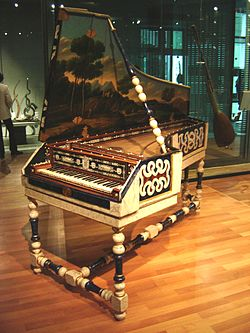
The harpsichord (also called harpsichord, cembalo, gravicémbalo, clave or clavicímbalo) is a musical instrument with a keyboard and plucked strings, such as the harp and the guitar. The key, well known and used during the Baroque, was falling into oblivion, and most of the pieces written for him began to be interpreted in the new pianoforte, ancestor of our modern piano. As its name suggests, it allows volume changes by simply varying the intensity of the keystroke. It is believed that it derived from the Greek Psalter (psalterion), although its invention occurs during the Renaissance, in the middle of the XV and XVI centuries. Screwdriver mechanism of a key. Its basic structure is one or two keyboards or manuals, in which, when pressing each key, a quill of goose, crow or condor feather (called plectrum), which is found in a small wooden structure called a pile driver or jumper, raise the corresponding rope, puncturing it. This produces a certain sound (note). The volume of the instrument does not vary, at least noticeably, according to its keys are pressed softly or strongly, only a volume change is achieved by adding records or coupling them. The art of embellishing a melodic line also suggests dynamic effects. In the late nineteenth and early twentieth century, the instrument was revived, in part, thanks to the pianist Wanda Landowska, who was the first teacher interested in the key in modern times (in the city of Berlin), and not only played ancient works written for the instrument, but also commissioned new works to different authors, including the Spanish composer Manuel de Falla. Landowska was not interested in the sound of the ancient keys, but rather encouraged the construction of modern keys, with structures derived from the construction of the piano (such as Pleyel harpsichords). With the excellent progress of restoration and manufacture of copies of the old instruments, for more than forty years interest in the historical key has resurfaced. The clarity of its timbre and exquisite richness in harmonics make it irreplaceable for the performance of polyphonic music. The key has smaller variants, such as the spinet and the virginal, which should not be confused with the clavichord. The key has played an important role in European academic music from the sixteenth to the eighteenth century and, later, in the twentieth century, either as a soloist, as a companion or alone, having its golden age in the Baroque, and then falling into Oblivion in Romanticism and resurgence with strength in the twentieth century. The contributions of Italian musicians, such as Girolamo Frescobaldi, Germans, such as Johann Jakob Froberger and Johann Sebastian Bach, Frenchmen, like François Couperin or Jean-Philippe Rameau, and Domenico Scarlatti who composed most of his keyboard work in Spain, creating a own school among whose followers figure authors such as Sebastián de Albero or Antonio Soler, created a classical repertoire for this instrument during the seventeenth and eighteenth centuries. The interest in composing specific music for the instrument dates back to the Middle Ages, a stage from which anonymous manuscripts with works for soloist keyboard date. Interest in nearby instruments, such as the clavichord, the virginal or the spinet, will grow until the late Renaissance, when the first great composers appear in the field of keyboard music. The Spaniards Antonio de Cabezón (1510-1566) and Antonio Valente (1520? -1580?), Along with the English virginalists from 1560 to 1600, write the most interesting works of Renaissance music for this mechanically pressed string instrument. Shortly thereafter, the music for key of Jan Pieterszoon Sweelinck (1560-1621) undertakes the transition towards the early Baroque. The key enjoys more and more popularity and recognition, and after the contributions of Cabezón and Valente, the English virginalists and the Dutchman Jan Pieterszoon Sweelinck, between the end of the 16th century and the 1630s, will open an important time in key music, which covers the entire Baroque, from 1600 to 1750, and will gather a very large corpus of works composed by musicians from all over Europe. But the instigator of the classic forms for the European baroque key is, without a doubt, the Italian Girolamo Frescobaldi (1583-1643), who established a repertoire of tocatas, caprichos, fantasías, ricercare (generic name for any contrapuntal piece) and variations or virtuous differences for the harpsichord only in the first half of the seicento. Following his wake and influenced by him arise the schools of the baroque harpsichord in the second half of his seventeenth century. England (with Henry Purcell), Germany (with the very personal music of Johann Jakob Froberger) or France, although in the French case it remained a tradition of its own in the 17th century,
TOP 6:
Recorder
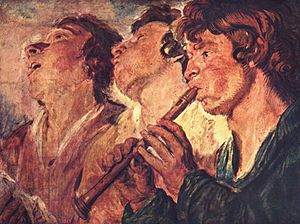
The recorder or recorder is a very old wind instrument. Popular from the Middle Ages to the end of the Baroque, its use was relegated to the development of the classical orchestra, populated with more sonorous instruments. From the twentieth century returns from museums, in principle for the interest of interpreting Renaissance and Baroque music with their original instruments, but its worldwide dissemination is based on the pedagogical possibilities as a tool for musical initiation. From the Renaissance, the flute is constructed using and forming families that resemble the tonal distribution of the human voice, through sets (consorts, in English) also common in string instruments (violin, viola, cello and double bass). For this reason there are sweet flutes of less than 15 centimeters in length, up to models of more than 2 meters and a half. The most widespread and known, however, are the soprano recorder, a common instrument in schools for musical initiation, and the contralto recorder or sometimes also called a high flute. They all have a tune of two and a half octaves, and in general they are instruments tuned in C or F: The recorder is held upright, with the left hand closest to the embouchure. A correct technique involves attending to the emission of sound, its articulation, and the fingering that allows to generate the different notes. The broadcast is of a "natural" nature, avoiding the idea of "blowing". The mouth of the instrument is a "block" (A) into which a wind channel (B) directs the air directly against a sharp edge or tongue (C), which transmits its air vibration towards the air column inside the flute. For this reason it is relatively simple to produce sounds, although the position of the mouth produces remarkable variations in the quality and timbre of the instrument. The articulation is fundamental for the separation between notes, allowing the expression of the interpretation. The technique of articulation is common to practically all wind instruments, and consists of the so-called "touch of language", whose variants produce different modes. The touch of language is achieved by articulating simple phonemes (without vibrating the vocal cords of the interpreter), achieving for example: normal style: tu-tu-tu articulation legato: du-du-du staccato articulation: ttt articulation non legato: dad -dad-dad double staccato articulation: tu-ku-tu-ku The handling of this technique allows cleaning in the fast passages, and important expressive possibilities. Treaties such as "La Fontegara" by Silvestro Gannassi, published in Venice in 1535, mention an additional type of articulation with the name of "Lingua riversa" in the inverted sense or "upside down". Gannassi proposes the syllables le-re with variants in all the vowels. A similar type of articulation is cited in some later treatises, for example Joachim Quantz with the syllable did'll. The effect that is sought is to create a sort of superposition of the notes regardless of the hardness of the initial attack. The flexibility of this technique with which you can create notes ranging from an almost legato to a soft stacatto, led her to be considered one of the main types if not the main one to articulate fast passages with elegance (Dalla Casa). In modern flute schools, mostly from the Anglo-Saxon side, this technique is studied based on the Quantz treatise (did'll). An univocal criterion on how to approach this articulation based on the legend of Gannassi does not exist. However, observing the tendency to gutturality that still exists today in the pronunciation of the r in the north of Italy, one might think that a r understood as a soft g together with a compression of the phonemes, a natural consequence of the speed of the passages, could lead to a kind of legllegl in natural form, creating in this way an effect practically equal to did'll already mentioned. In the seventeenth century there were several changes in the construction of the instrument, resulting in what is known as "recorder". The innovations allowed this mark in a tessitura of two octaves and chromatic half, and obtaining a timbre more "sweet" than the previous models. During the seventeenth century, in somewhat confused form, the instrument is often referred to simply as "Flute" (Flauto in Italian), while the transverse flute is called "Traverso". For this recorder was that Bach wrote his 4th Brandenburger Concerto in G major, although Thurston Dart wrongly suggested that it was written for flageolets. Actually, Bach wrote this work for two "flauti d'echo", or flutes of echo, an example of which survives until today in Leipzig. It consists of two sweet flutes in fa, connected by leather eyelashes, so that one of them is used for t
TOP 5:
Viola da gamba
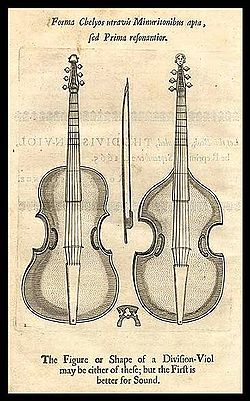
The viola da gamba is an arc cordófono, equipped with frets, widely used in Europe between the late fifteenth century and the last decades of the eighteenth century. The most widespread model has six strings tuned by quarters (with a third major among the central ones), an aspect similar to that of the cello, an extension of re a re ", and is played by taking the arch palm up.The interpreter is known as His name, of Italian origin, means "viola de leg." It is thus opposed to that of the conventional viola, called da braccio (arm), and to the viola of a hand held in. It is due to the way of being held by The musician, between his legs Although the expression "viola da gamba" has been imposed in Spanish-speaking countries, the instrument has been called in Spanish in many other forms throughout its history, such as "vihuela de arco" ( Cerone, 1613), "vigüela de arco" (Covarrubias, 1611) or "violón" (Ortiz, 1553) In French it is called viole, in English viol and in German Gambe There is a great variety of historical models of viola da gamba However, we can point out a series of characteristics Typical construction practices that usually coincide in most of them: Curved fingerboard with seven frets. Box with drooping shoulders and flat bottom, with slope towards the handle. Carved harmonic table. Pronounced notches. Ears in the shape of a C. Curved bridge. Gut strings (the most serious wound with metal), in number between five and seven. Tuning by quarters with a third major interspersed. Carved headstock with figurative motifs. Similarly, the ways of playing the instrument usually coincide in: Holding the instrument between the legs, even the smallest ones (with the exception of very large violas, resting on the floor) and holding it vertically, with a slight inclination from the handle to the left of the musician. Take the palm-up bow with a finger in direct contact with the bristles, a technique similar to the traditional one in folkloric stringed instruments. As for the size and, consequently, the tessitura, the violas da gamba constitute a broad family. The sizes most in use are those of soprano, tenor and (above all) bass, but there is a great variety of models. From minor to major we can find: The French quinton, instrument of mixed tuning between the violin and the pardessus de viole: sol-re'-la'-re "-sol". The pardessus de viole French, tuned sol-do'-fa'-la'-re "-sol". The viola soprano, tuned re-sol-do'-mi'-la'-re. "The viola alto, rarely used, tuned La-re-sol-si-mi'-la." The viola tenor, of identical tuning to the Renaissance lute in Sol: Sol-do-fa-la-re'-sol. "The lyra viol, seventeenth-century English model of somewhat larger size than the viola tenor and to which various tunings were applied to interpret music by The viol division, an English instrument described among others by Christopher Simpson (Simpson, 1659), of a tuning similar to that of the viola bajo, but smaller in size, suitable for solo use, the bastard viola, an Italian name that could be identified with the viol division The viola bajo, tuned Re-Sol-do-mi-la-re 'It is, by far, the most used model of the family, from Diego Ortiz (S. XVI) to Abel (S. XVIII) , and is today the basic model in the regulated teaching of the instrument, Sainte-Colombe imposed in 17th century France a variant of seven strings, adding another string serious (La,). By the acute its extension in the repertoire usually reaches the re ". The violone in Sol, tuned Sol, -Do-Fa-La-re-sol. The violone in Re, tuned Re, -Sol, -Do-Mi-la-re. However, at all times there have been a large number of alternative tunings collected in historical treaties: for example, in France of the XVIth the violas used to be played in sets consisting of five-string instruments tuned entirely by fourths, as happens with many later violons. We must also note the remarkable confusion of terms between lyra viol, division viol and viola bastarda. Currently research is being carried out on the production of new models of viola da gamba, some of them electric. Already in the Middle Ages there are representations of stringed instruments, such as vihuelas de arco and rabeles, which are played with bows and held between the legs of the musicians. It is necessary to wait until the end of the 15th century to register the first instruments with the characteristics of the viola da gamba, such as the fretboard with frets and the recesses. Abundant iconographic testimonies of ca. 1500 support the hypothesis that this instrument was created in the domains of the Crown of Aragon (Kingdom of Valencia, Balearic Islands, Sardinia, southern Italy) as the evolution of the hand vihuela, to be struck with bow following the Moorish technique of rabel, even then very widespread in V
TOP 4:
Lute
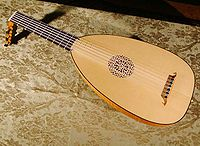
The lute (from Arabic العود al-`ūd) is a plucked string instrument, whose origin dates back to the Middle Ages and whose introduction into Europe was through Islamic Spain (Al-Andalus). By extension, lute can designate any instrument in which the strings are placed in a plane parallel to the box, along an outgoing mast. It was widely used between the 14th and 18th centuries, and also re-emerged in the 20th century. The lutes found in the east and medieval, Renaissance and Baroque lutes have a bulging resonance box, made with longitudinal staves or ribs, or carved from a block of wood (pipe, medieval lute). The tenor tessitura instrument, usually used in the tuna and in rondallas, called the Spanish lute, has a flat bottom and side rings, and in spite of its name, it is not related to the old lutes, but rather to the bandurria. It consists of the following parts: Pegs: are elongated wooden pieces, with a slight conicity, in which the rope is wound to tighten it. Frets: they are strings of gut knotted around the mast. They shorten the string to the desired length when the performer steps between two of these frets. Mast: it is the elongated handle that emerges from the body of the instrument on which the strings are laid and the positions of the hand that is used are executed. Fingerboard: is the sheet that covers the neck to protect it from wear and give rigidity, because on it the performer's fingers are supported when stepping on the strings. It is usually ebony. Resonance box: bulged, built from longitudinal ribs, shaped like a half pear. Mouth: in the old lutes shows a finely carved decorative rosette. Strings: they are of gut the acute ones, and of nucleus of gut and twisted of metal, the serious ones; there are six double strings tuned in unison in pairs, like those of the bandurria. Bridge: also called bar-chordal, in it the strings vibrate directly from the knot, without leaning on any sheet, like the current guitars. Cordal: only some medieval lutes had a separate piece to knot the ropes, because from then until the eighteenth the bridge and the cordal coincided in a single piece, the bar-chordal. The interpreter takes the instrument in a manner similar to the guitar. With the hand with which he writes, in the case of oriental, medieval instruments and that of the Spanish lute, he strings the strings with a pick or plectrum. From the medieval era the use of the quill was abandoned, and the interpreter played with the tips of the fingers or the nails themselves. This technique provided greater expressive freedom and that is where the technique of the skillful hand of the current guitar comes from; the resources of the barb are smaller than those of the fingers. With the opposite hand, he steps on the strings allowing the formation of chords and the execution of melodies. In the case of the theorbo, the archilaud, the baroque lute, etc., there are also bass strings, called bass strings, which are not stepped on, as they do not pass over the fretboard, but they do touch with the skillful hand. produce bass notes at a certain moment of a solo piece, or to accompany more acute instruments. Great composers and interpreters of the Baroque and Renaissance period were John Dowland, Giovanni Girolamo Kapsberger or Robert de Visée. The word lute derives from the Arabic voice `ūd (عود), one of whose meanings is 'wood'. The lute used in the Arab countries and in all the Middle East lacks frets, because these would prevent the realization of quarters of tone, necessary in the Eastern scales. It has a slightly shorter mast, compared to the European lute, and a larger sounding board. It usually only has one bordona and four double strings, although there are lutes of up to seven orders. Its registration is usually two and a half octaves. This instrument is used in classical and popular music of all Arab countries, as well as Turkey, Iran, Pakistan, Armenia, Georgia. The body is shaped like a crushed pear, carved from a block of wood, and four ropes. There are references that date from its existence in the 2nd century BC. C. Usually accompanies the singing of poems, often epic, which describes battles or relevant historical events. Although it is also used in musical groups, the Chinese pipe or lute is mainly used for the interpretation of solos. The pipe repertoire consists of traditional Chinese works, mostly anonymous, and contemporary music by composers with both Chinese and Western influences. It is played by a technique with spectacular dexterity of fingers, to achieve characteristic sounds. Liu Fang is an accomplished interpreter of this instrument. The lute enjoyed a revival with the awakening of interest in historical music around
TOP 3:
Organ (musical instrument)
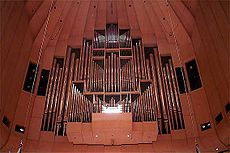
An organ is a keyboard musical instrument. The sounds are generated by passing air through tubes of different lengths (from a few centimeters to several meters). It is classified as a wind instrument or aerophone in the instrument category of keyboard and also within the sub-category blown air, next to the accordion and the harmonium. It consists of different registers or sounds, whose timbre will depend on the form, size, material or mechanism of sound production. It is managed by one or more keyboards to play with the hands, and another consisting of pedals at the bottom. The different registers are activated by means of levers or buttons within reach of the hand of the one who plays the instrument. In the past, air was supplied by hand-operated bellows. Currently, it is also supplied by compressors. The organ is played with hands and feet, which makes it advisable to study other keyboard instruments in order to be able to study as an instrument. The tubular organ originated in Greece by the ancient inventor Ctesibio, who devised various contraptions that worked with water and air, such is the case of hydraulis. The organ was known to the Romans and was adopted by the Roman Catholic Church and other churches as an accompaniment to religious services in the seventh century. Throughout history, the organs have been portable and fixed, according to whether or not they are ready to be moved. hydraulic or pneumatic, depending on whether the air is generated by the tension or pressure of water (cold or hot), or by manual or electric bellows (which is the system currently in use). The invention of the bellows currently in use seems to date back to the 4th century in the East, as they are drawn in a bas-relief of the obelisk of Theodosius in Istanbul. Until the twelfth century the two systems were used, always being very embarrassing and by the thirteenth century the hydraulics were completely abandoned. Since then, this instrument has been generalized in the churches, slowly gaining its perfection until the 16th century. In the fourteenth century the game of the bellows was simplified, which previously demanded the strength of many men and the keyboard became chromatic before being diatonic. In the fifteenth century, organs of larger and fixed dimensions were built, the portable ones and small ones for smaller churches continued, and pedals were added. In the sixteenth century the size of the organs was increased, they were enclosed in a box, as we know them today and the superposed keyboards were invented. In the 19th century, the extension of ten octaves with five keyboards was perfected to the point of reaching a single organ. In the last decades with the application of electricity to the organs, it has been possible to simplify the leverage systems and give more speed to all movements. In European academic music, the organ, as soloist and soloist, has had great composers who gave him famous works, especially in the Baroque period, the golden age of the instrument, highlighting the contribution of Johann Sebastian Bach in the eighteenth century and Olivier Messiaen in the twentieth century. Already in the middle age there were collections of pieces for organ alone, leading, in the Renaissance, the first golden age. Antonio de Cabezón (1510-1566) is one of the best organists of his time and one of the most outstanding in the Spanish field. For the organ he wrote tientos, parades, variations, etc. In the baroque the organ had its apogee and golden age, as much in interpreters as in composers and organeros. In Italy the figure of Frescobaldi (1585-1641) stands out, where his work Fiori musicali (1635) is one of the most important works in the teclístico field. In the Netherlands there is another illustrious example with Jan Pieterszoon Sweelinck (1560-1621), who together with Frescobaldi are the first 2 geniuses of baroque keyboard literature. In France the organ had a lot of role in the musical life, there being even a school, the French school of the organ, which had its maximum apogee between 1660 and 1720. The most illustrious exponents of the school are F. Couperin (1668-1733) between others. After school, together with the school of the key, loses prestige and the French music of the instrument disappears before the indifference of the great composers, like JP Rameau (1683-1764). In 1790 the school is already in full decline, with only minor composers. In Spain there are many notable figures throughout the period, from Francisco Correa de Arauxo, Juan Cabanilles to Antonio Soler (1729-1783), where his organism production is the most important of the 18th century at the national level. In England the two most illustrious representatives are Purcell (1659-1695), who composed pieces of free theme and Händel (1685-1759), who composed concerts for organ and orchestra. In Germany the organ had an importance
TOP 2:
The harp
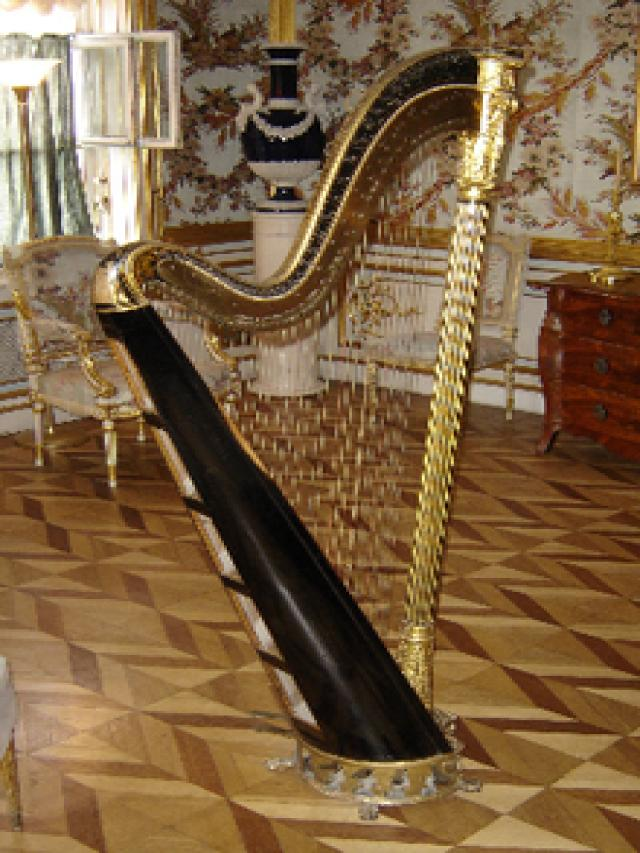
The harp1 is a pulsed string instrument composed of a resonant frame and a variable series of strings stretched between the lower section and the upper section. The strings can be pressed with the fingers or with a pick or plectrum. In addition to the classical harp, currently used in orchestras, there are other types, such as the Celtic harp and the Paraguayan harp. The harp is the national musical instrument of Ireland, Paraguay and Peru. Although there are very old instruments similar to the harp, it must be taken into account that the Hornbostel and Sachs classification distinguishes between the harp-type chordophones (with a neck that closes the bow) and the arc type (which do not have that mast). Thus, several of the primitive harps that are described in the history of the instrument are literally, musical arcs. There have been different forms, in different parts of the world, as in different times. Belongs to the group of cordophones. It was already known in ancient Assyria, in Israel and Egypt, from where it passed to Greece. They use the Greek term ki‧thá‧ra to translate the word kin‧nóhr more or less half of the forty-two times that appears in the Hebrew text. The ki‧thá‧ra was an instrument similar to the lyre (in Greek lý‧ra), but with a flatter resonance table.2 It was a very wedding instrument during the Middle Ages, being abandoned during the Renaissance. It was recovered in the eighteenth century, when the pedals were added. The European harp can be divided into two models: "Medieval harp," (of Irish origin), also known as the bardic harp. Not more than 75 cm in height and diatonic tuning, metal strings, ornamentally rich in carvings, drawings and inlays of metal. At present we still have two clear examples, one is the harp of King Brian Boru (died 1014) that can be found in the Dublin Museum, and another is the harp of Queen Mary of Scotland, in the National Museum of Scotland. Edinburgh. "Celtic harp" (of Welsh origin), can have up to 105 cm in height, 34 strings and with the possibility of incorporating semitone systems. Both have the curved pillar and its resonance box was widened in the bass strings. The medieval harp was diatonic, and the modern harp, on the contrary, was born with the first attempts of chromatism that the evolution of Western music demanded. The first attempts arose from the workshops of Irish luthiers in the sixteenth century, which provided the harp with a double row of strings. In the seventeenth century a third row was incorporated, the 1st the 3rd row were diatonic (29 strings each row) while the 2nd row, with 20 strings, was reserved for the semitones. In the mid-seventeenth century some Tyrolean builders invented the hook harp, with which it was possible to stretch the rope and raise it a semitone. At this time there were many built-in mechanisms to raise the tone, but all manually operated, so it had to be done before beginning the interpretation. At the end of the seventeenth century, the Bavarian luthier made the first harp with pedals that were located on both sides of the instrument stand, were attached to the fixed hooks of the console by a transmission system. There were seven pedals, corresponding to the seven degrees of the musical scale and for whose instrument Mozart wrote his Concerto for flute and harp in 1778. As a result of the discovery, numerous ideas were inspired which were more outlandish to expand the possibilities of the harp (as it was the placement of double number of pedals and mutes), but the greatest success was obtained by S. Erard in 1811. Erard presented the so-called "double action" model which, with slight later modifications, is the one normally used today. The pedals are attached to steel strips that are introduced into the column, these end in a mechanism located in the console which, in turn, is formed by several layers of sycamore and rowan. This mechanism, very elaborate, has two sets of forks, discs provided with adjustable screws between which the rope passes. When a pedal - called double action - is released (resting position in the upper notch), the rope passes freely between the screws (flat); hooked in the middle notch, the pedal prints the discs a partial revolution that produces the 1st semitone (becuadro); hooked in the lower notch, the pedal causes the continuation of the movement, which results in the 2nd semitone (sustained). Each one of the seven pedals acts on all the octaves of a same scale, being able to be acted twice, raising successively a semitone in all the notes of the same tonality. Now the number of strings rises to 47 and they are of different classes. There are 26 in the middle register that are of gut of ram, 10 or 11 in the acute register that are nylon, while the remaining 12 are alpaca or copper (wound in steel) for serious registration. The
TOP 1:
Fiddle
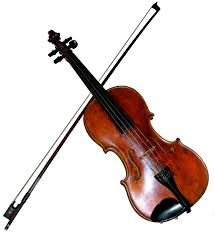
The violin (etymology: Italian violin, diminutive viola or viella) is a stringed instrument that has four strings. The strings are tuned by intervals of fifths: sol re mi (The number is indicated according to the international acoustic index, which is used throughout the world, according to which the central do of the piano is a do) The string of loudness More serious is that of sol3, and then follow, in increasing order, the re, the and my. In the violin the first string to be tuned is that of la; it is commonly tuned to a frequency of 440 Hz, using as a reference a classical forked metal fretboard or, since the late twentieth century, an electronic tuning fork. In orchestra and groupings, the violin is usually tuned to 442 Hz, since the conditions of the medium such as temperature, or the progressive release of the strings causes them to become out of tune, and to compensate for it they are tuned somewhat above. The body of the violin has a domed shape, with a stylized silhouette determined by an upper and lower curvature with a narrowing to the waist in the form of a C. The violin covers are modeled with soft curves that provide the characteristic of vaulted. The hoops, which go around the violin giving the silhouette, are of low height, the mast has a certain angle of backward inclination with respect to the vertical, longitudinal axis and is topped by a spiral called volute. The internal structure of the violin are two fundamental elements in the sound production of the instrument given by the harmonic bar and the soul. The harmonic bar runs along the top just below the bass strings and the soul is located just below the right foot of the bridge where the high strings are located. Violin music scores almost always use the treble clef, formerly called "violin clef". The violin does not have frets, unlike the guitar. It is the smallest and most acute of the family of classical stringed instruments, which includes the viola, the cello and the double bass, which, except for the double bass, are all derived from the medieval violas, especially from the fidula. In the old violins the strings were of gut. Today they can also be made of metal or gut wound with aluminum, silver or steel; the rope in me, the sharpest -called cantino- is directly a steel thread, and, occasionally, gold. At the present time, strings of synthetic materials are being manufactured that tend to gather the sonority achieved by the flexibility of the casing and the resistance of the metals. The arch is a narrow rod, smooth curve, and ideally built in the hard wood of Brazil wood or "Pernambuco" (Caesalpinia echinata), about 77 cm long, with a 70 cm tape constituted by between 100 and 120 (with a weight of about 60 grams according to length and caliber) horsehair mane, being the best quality so-called "Mongolia", which come from cold climates where the hair is thinner and more resistant. Such tape goes from one end to the other of the arch. For the strings to vibrate and sound efficiently, the horsetail ribbon of the bow should be properly and regularly rubbed with a resin called rosin (in Spain it is called "perrubia", of "fish-blonde"). Also, nowadays - many times to reduce costs - the bleached horsehair is replaced by vinyl fibers. The bow of the violin has in the part by which a screw system is taken that when making move the piece by which clings one end of the horsehair ribbon causes that this is tensed or distended. The violin is the cheapest instrument of his family, but it is also the one that reaches the most exorbitant prices. The violins are classified according to their size: the 4/4 - whose length is usually 14 inches or 35.5 cm and its maximum width of 20 cm, and a height of 4.5 cm - is the largest and is the one used by adults; violins of smaller size follow, destined to young people and children, denominated 3/4, 2/4 and 1/4. There is also a violin of size 7/8, also called "Lady", which is used by some women or by adult males with small hands. However, the genealogy that leads to the current violin is more complex. It is found in the rubbing of the strings of the lute and the rebab -and its European version, the rabel-, instruments spread in Mediterranean Europe during the medieval expansion of the Arabs. In Italy, from the Byzantine lyre or the rebab, the most obvious antecedents arise, both of the violin and of the so-called viola de gamba; such precedents are the viola de arco (name that was used for any bowed string instrument, such as rebec or rabel, and that also recie the denominations of viela, vihuela, vihuela de arco, fídula and giga) and the lira or viola da braccio, is already very similar to a primitive violin or viola, although with the fretboard separating the bordon


